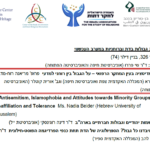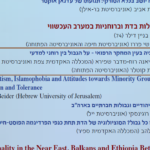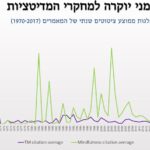Is there a connection between the fact that Mindfulness has become fashionable in the cultural space and the scientific recognition it has received? How did Mindfulness turn from a spiritual practice to a evidence-based scientific practice?
In this lecture, we presented the development process of the scientific-medical discourse about Mindfulness, in an unusual context: observing this phenomenon as part of a cultural process.
One of the main conclusions was that the intensity of the secularization and the Westernization of the meditation is a predictor of the degree of its acceptance in the Western discourse.
The lecture was held as part of the session “Boundaries in Religion and Spirituality in the Contemporary West” (Chairman – Shai Ferraro), at the 5th annual conference of the Israeli Association for the Study of Religions, dedicated to the topic “Boundaries in Religion”. The conference took place on May 25th, 2022, at Ben Gurion University in the Negev, in collaboration with three centers of the university: the Center for the Study of Conversion and Interfaith Encounters, the Haim Herzog Center for the Study of the Middle East and Diplomacy, and the Elyashar Center for the Study of the Jewish Heritage of Spain and the Middle East.
A similar lecture was held at another conference – see links below.
This research takes part both in the research project about the academic discourse and in the research project about the Orient in the West.
Abstract
The tremendous prosperity of the mindfulness fashion in Western societies takes place in parallel to its prosperity within the medical-scientific discourse, as an anchor for its social legitimacy. In order to study this surprising process in which the meditation practice crosses the border between spirituality and science, we examined the processes that made this acceptance process possible.
The success of Mindfulness meditation in the scientific discourse stands out especially in comparison to another meditation of Asian origin, whose agents tried to gain scientific legitimacy, without much success – Transcendental Meditation (TM).
We examined the development of the scientific-medical discourses and their characteristics regarding the two methods of meditation – both with quantitative tools (the number of articles and their prestige indices), and with qualitative tools (the personal interest of the researchers, use of spiritual terms). The quantitative database included 6180 medical studies published in PubMed between 1970 and 2017, from which a qualitative sample of 50 articles was selected. All the studies in the sample come to positive conclusions (recommendations) regarding the two meditations, that is – they are mobilized in their favor. However, mindfulness is supported on a much larger scale and with infinitely higher prestige indices.
The comprehensive analysis shows that the more meditation is presented as detached from religious contexts, the more legitimate it becomes in the scientific field. Unlike TM, Mindfulness meditation is presented as detached from a religious, metaphysical or Asian context, and embedded in the conventional Western-scientific framework. To this end, the scientific discourse about Mindfulness renounces worship and dogma, emphasizes its detachment from a religious or metaphysical context, while avoiding spiritual/religious terms, and deals with precise measures, secularized goals, and makes extensive use of advanced technological equipment. MT is indeed presented using efficiency indicators, however it preserves the metaphysical cosmological discourse and the spiritual Asian context, and accordingly – it failed to mobilize the overwhelming legitimacy that Mindfulness garnered.
The various indicators we examined actually point to the volume of the secularization and westernization of meditation as a predictor of its absorption in the Western discourse, and thus – it turns out that it is not the West that is Easternalizing (as some scholars claimed), but rather the East is the one that gets Westernized.
Below is a video recording of the lecture (in Hebrew), accompanied by the presentation, including the discussion that took place after the lecture:
Lecturers
Marianna Ruah-Midbar Shapiro
Orit Kotler
Links
For the conference program (in Hebrew) in a graphical format – click here.
For the detailed program (in Hebrew) in a textual file – click here.
For the Call For Papers (with the conference’s subject rationale) – click here.
For the English webpage on the Israeli Association for the Study of Religion’s (IASR) site – click here.
Date
May 25th, 2022
Language
Hebrew
Academic/Non-academic
Academic item

















